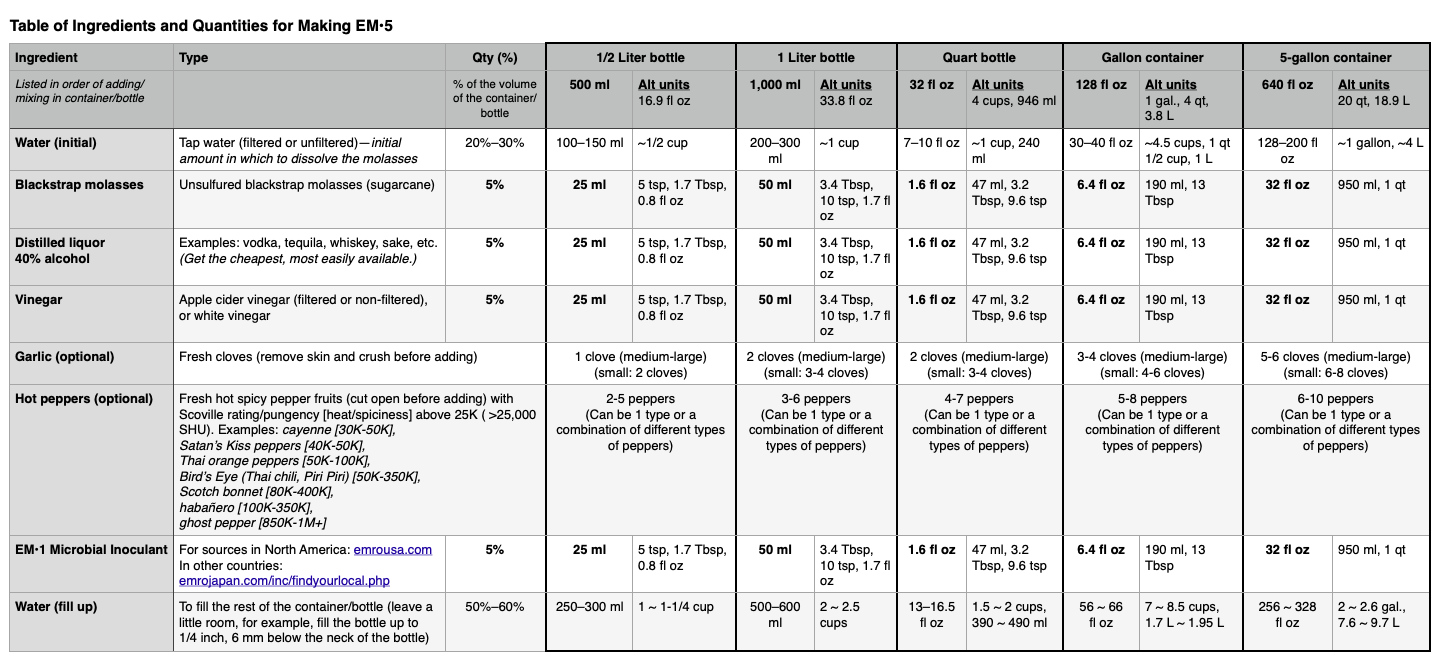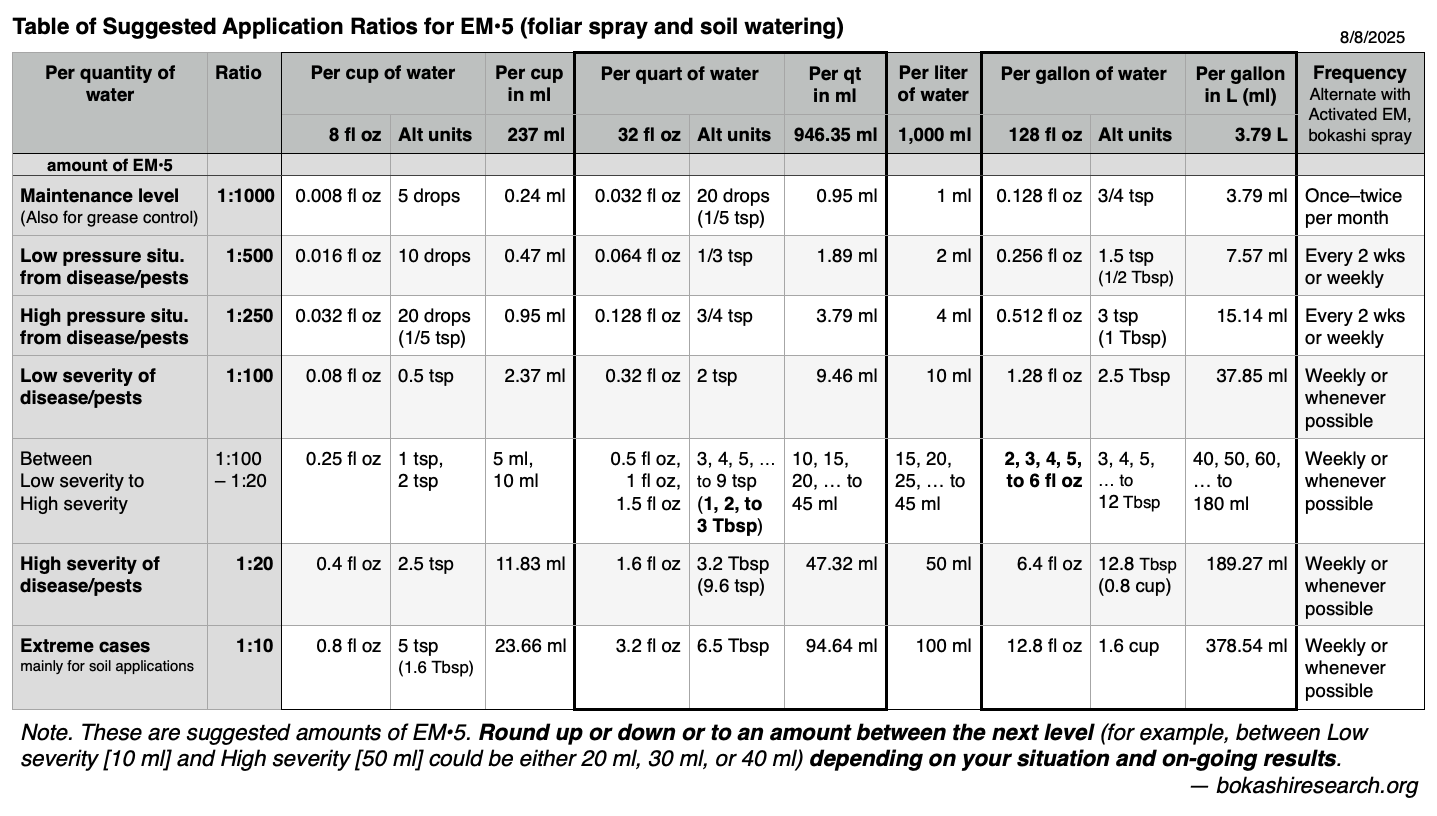For soil, foliar feeding, and other uses, EM•5 is used as a foliar spray and for inoculating the soil. It is a more potent version of Activated EM•1 and lasts much longer. It can be made at home using simple ingredients with EM•1, which consists of naturally occurring microbes (lactic acid bacteria, yeast, and photosynthetic bacteria) that are usually not found together. EM•5 is used to directly apply to plants (avoid the flowers in some instances) and to condition the soil.
How to Make EM•5
Preparations
- Implements - bowl or bucket to mix in, measuring cup, PETE plastic bottle(s) or glass bottles with an airlock, and (optional) funnel. Also, after making and letting the EM•5 ferment, you will need either a spray bottle sprayer or a mister.
- Water - preferably warm water (optional)—heat enough to fill your bottle(s).
Ingredients
[Example quantities for making 1 quart, 32 fl oz. For various quantities, see table below.]
- EM•1 Microbial Inoculant (a liquid containing a combination of naturally existing microbes found in foods, soil, and water: lactic acid bacteria, yeast, and photosynthetic bacteria.) [5%, 1.6 fl oz or 5 tablespoons]
- blackstrap molasses (blackstrap, unsulfured sugarcane molasses; or high mineral content sugar material — if using some other sugar source, add a teaspoon of sea salt for mineral content.) [5%, 1.6 fl oz or 5 tablespoons]
- distilled liquor (40% alcohol, such as, vodka, tequila, whiskey, sake, etc.) [5%, 1.6 fl oz or 5 tablespoons]
- vinegar (for example, non-filtered apple cider vinegar; white vinegar is also fine) [5%, 1.6 fl oz or 5 tablespoons]
- water (optional: heated to 100-120°F to make it easier to dissolve the molasses; otherwise, simply dissolve with a clean hand)
[to fill the remainder of the bottle—have at least 1 quart of water readied]
Optional ingredients
- garlic 1 to 3 cloves (un-chopped cloves, but removed from the garlic bulb and skin) — for fungal issues.
- hot peppers 1 to 5 (uncut whole peppers, one or more of the following different types: cayenne peppers, Thai pepper, tabasco pepper, serrano pepper, Scotch bonnet pepper, rocoto pepper, habanero chili pepper, Bhut Jokokia, i.e., ghost pepper, etc.) — for pest issues.
- sea salt [1 teaspoon] — adds minerals and is helpful if using EM•5 for cleaning and deodorizing.
- liquid mineral extract [a few drops to a dribble].
- lemon [1 whole lemon, juice squeezed and the peel sliced and added] — for cleaning, antiviral and anti-pathogenic properties; adds lemon scent.
- You can also add other plant, root, or herbal materials (generally high in antioxidants and known for their property where the fermentation can incorporate or enhance that property): garlic, ginger, orange peel, neem, etc.

How To Mix
- Mix the liquid materials using a bowl or bucket that holds at least 1.5 quarts, and add just 2 cups of water.
- Mix in the molasses first. If using warm water, the molasses should dissolve on its own. Otherwise, make sure to dissolve all of it (if by hand, rub it inside the bowl or bucket until the slimy feel of the molasses at the bottom is gone; alternately, a whisk may be used).
- Add the vinegar and liquor next, and add the EM•1 last (you will add any optional ingredients in step 5 below.
- Pour the mixture into your bottle (PETE bottle, such as a soda bottle which can handle any gas pressure buildup, or a glass bottle with a proper airlock-—DO NOT use a glass bottle without a proper degassing mechanism, such as an airlock; the glass bottle can explode if not degassed or burped). A funnel would be helpful to pour into the bottle.
- Add any optional ingredients, such as three or more sliced garlic cloves, hot peppers, etc.
- Let ferment for about two weeks or longer at room temperature.
Keep away from direct sunlight.
You can use a pH meter or pH paper to test for when the fermentation is complete. The EM-5 is ready when the pH is below 4.0, preferably around a pH of 3.5 (range of 3.2 to 3.7).
If using PETE bottles (plastic soda bottles that can hold carbonation gas buildup), check for gas buildup daily. Release the gas by slightly opening the cap until the gas is released, and do so over a sink or bowl in case of liquid overflow.
When ready, apply as suggested below, and use within six months (it may last for as long as one or two years, but it may not be as strong with viable microorganisms).
Keep at room temperature. Store out of sunlight.
Applications of EM•5

For a printout (PDF) of this Table with QR codes >
- Dilute with water at the suggested ratio in the table above and spray directly onto the leaves. Avoid applying directly to the flower petals or perform a test beforehand. During high disease or pest pressure, the dilution can be stronger, such as 1:500 or 1:250.
- Fill a 32-fl oz hand-held spray bottle with water and add a little less than 1/4th of a teaspoon (1 ml) of EM•5.
- If applying to the soil, use a watering can at a heavier/stronger dilution rate of 1:500 at 1.5 to 2 tablespoons (25 to 30 ml) to 1 gallon (3.79 liters).
- The maintenance level (1:1000) is also good for grease control in grease pits.
- Applications are most effective when done in the early morning. They could also be done at night. Do not apply during the middle of the day to avoid damaging the plant.
- After the first application, apply on alternate weeks or once per month.
- For best results, alternate with regular Activated EM (bokashi spray) applications.
